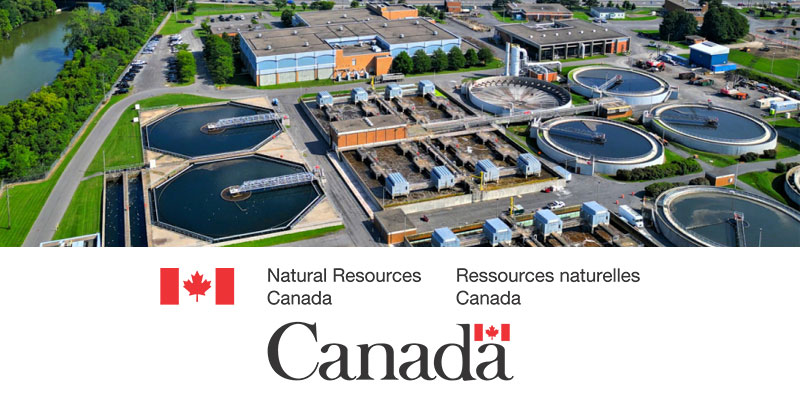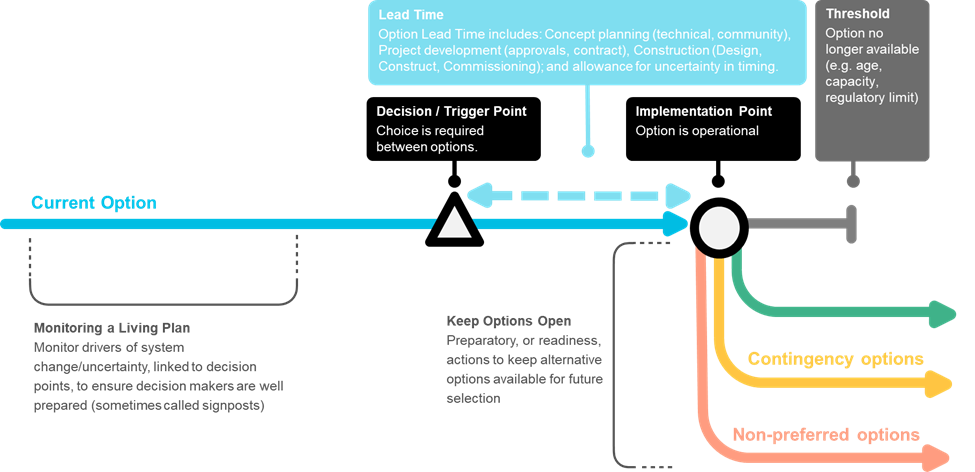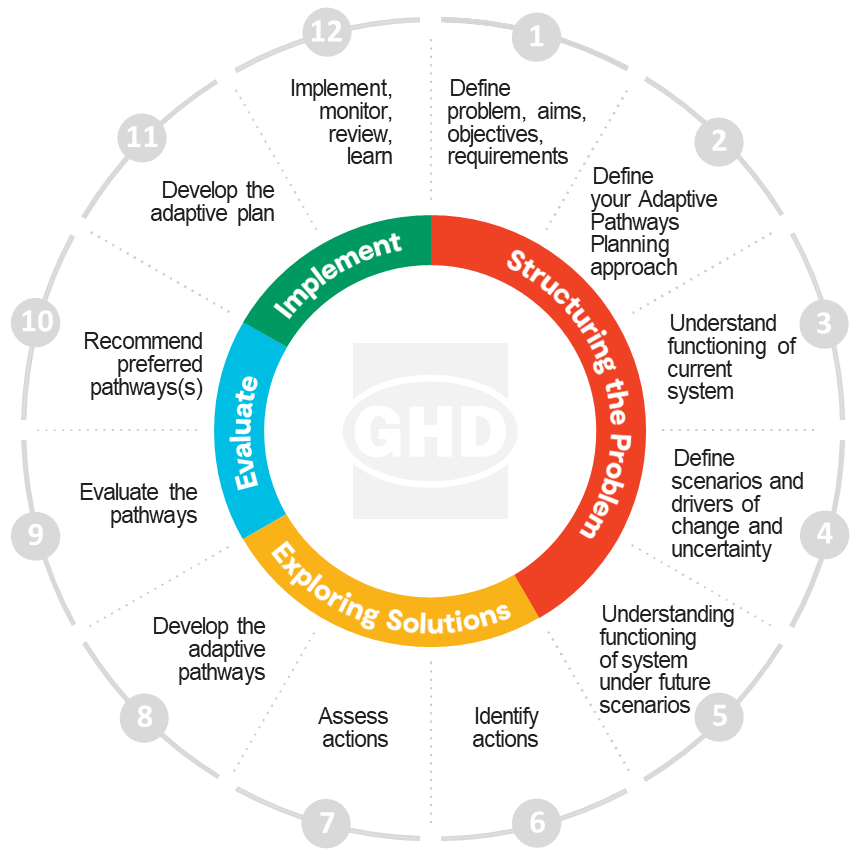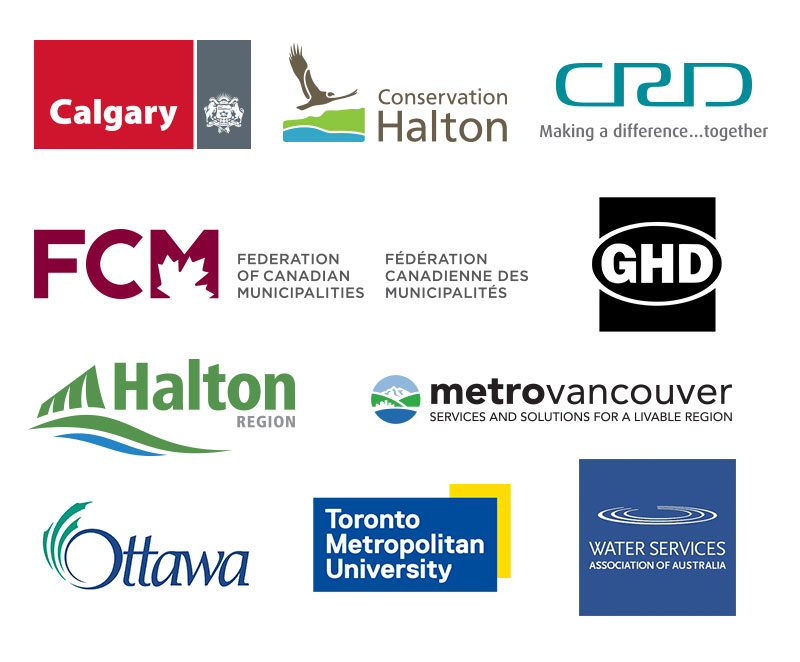Adaptive planning for Canadian water utilities
Canadian Water Network (2024–2026)

Challenge
Drought, flooding, population growth, and other future risks are significantly impacting communities across Canada. Decision-makers, including water and wastewater utility managers, face the challenging task of accounting for uncertainty in their planning processes. While conventional planning approaches address some uncertainty, they often lack the flexibility needed for cost-effective modifications as conditions evolve over time. This leaves utilities in a challenging position, where plans fail to align with or adapt to the new conditions.
How can future potential uncertainties be integrated into critical plans, such as watershed and land-use planning, zoning, water supply, wastewater and stormwater management, and flood risk control?
Project
This project is supported by Natural Resources Canada’s Climate Change Adaptation Program.
Adaptive planning is an approach to water management and infrastructure planning that considers future uncertainty to generate multiple solution pathways. CWN is leading an adaptive planning project to adapt international best practices for use by Canadian water management professionals.
While the concept of integrating adaptation into water and wastewater plans is relatively new in Canada, international water professionals have made significant strides in this area. They have developed guidance frameworks, principles, and practices that incorporate uncertainty and risk into long-term water, wastewater, and stormwater planning to address plausible future scenarios. Examples of adaptation frameworks that support the concept of “living plans,” which can be more easily adjusted over time, include the adaptive pathways planning (APP) framework and water sensitive cities (WSC) systems approach. These frameworks have been applied in countries such as Australia and the U.K. to help utility decision-makers incorporate uncertainty in long-term water and infrastructure planning.
Figure 1: Key adaptive pathways features (GHD, 2024)
Adaptive planning helps decision-makers develop flexible plans in the face of future uncertainty and risk. The process considers potential future conditions under different scenarios to generate multiple pathway solutions based on possible or likely outcomes. Future uncertainties — extreme weather events and impacts, population growth and development, aging infrastructure, and changing economic, political, or regulatory conditions — can be assessed to determine solution pathways. A critical feature of the adaptive planning framework is continuous monitoring throughout the life of the plan, enabling decision-makers to adjust and modify the plan depending on trending conditions.
Figure 2: Adaptive pathways planning process (GHD & Trioss Global, 2018)
Adaptive planning creates the space to consider alternative options for each possible scenario, helping to mitigate the risk of failing to secure the necessary investments for adapting to future conditions. Regular monitoring, evaluation, and assessment processes are built in, ensuring that decisions are always informed by the most up-to-date knowledge.
The purpose of Canadian Water Network’s (CWN) project is to support the integration of adaptive planning methods and practices for municipal water management and infrastructure planning in Canada. The project goal is to develop adaptive planning implementation guidance that will enable Canadian municipalities to effectively apply adaptive planning for long-term water infrastructure and management.
For this project, CWN has engaged a National Steering Committee to advise on the adaptation and integration of trusted international guidance, principles, practices, and systems approaches for use by Canadian municipalities. The Steering Committee comprises municipal, watershed, academic, and project partner representatives.
The project will also convene a National Community of Practice, comprising Canadian municipal water utility leaders (starting in early 2025 and going through to mid-2026), that will enable members to learn, discuss, and share lessons learned on integrating adaptive planning principles to regional and organization-specific contexts, as well as develop relevant knowledge products.
The project will leverage retrospective pilot and case studies applying adaptive planning methods to municipal water infrastructure and management plans to refine and tailor guidance for Canadian municipal water utility professionals.
Outputs
- A national community of practice supporting knowledge sharing and learning on adaptive planning processes.
- Adaptive planning guidance for Canadian water utilities and water management professionals based on international best practices.
- Pilot and case studies on adaptive planning for water supply, wastewater treatment, and stormwater management planning to further customize adaptive planning guidance for Canadian water utilities.
Insights from water utility leaders
CWN conducted a series of interviews in fall 2024 with water utility leaders from across the country to understand the existing water and wastewater master planning landscape. CWN learned that the top planning drivers in Canadian communities are:
- Growth and development.
- Regulations, including environmental requirements and growth or development requirements.
- Risk management associated with aging infrastructure and climate change impacts.
Water utility leaders highlighted that population growth and infrastructure needs are common challenges in master planning. As population growth increases, utilities face mounting pressure to ensure that critical infrastructure sustains current and future demands, all while grappling with infrastructure deficits.
In light of these challenges, adaptive planning offers utility leaders an opportunity to improve community visioning, increase stakeholder engagement by illustrating the challenges that utilities face and the decisions they must make, ensure financial preparedness, and mitigate future investment risks.
Fall 2024 workshop insights
In October 2024, CWN held the project’s first in-person workshop with the National Steering Committee in Montreal. The meeting brought committee members together to discuss the knowledge gaps and needs of Canadian urban municipalities and the direction they would like to see the project take.
Committee members highlighted the importance of adaptive planning as a living process that involves planning for multiple future scenarios rather than just one; this concept is crucial to the success of future-focused master planning. They also emphasized that garnering buy-in from senior management and elected officials is critical to successfully implementing an adaptive planning framework. Additionally, members noted that all key stakeholders, including Indigenous community members, should be engaged throughout the implementation process.
Within the Canadian context, committee members emphasized that adaptive planning guidance should be applicable for both the corporate and infrastructure planning levels and mindful of multiple target audiences, including end users (utility project managers) and decision-makers (utility leaders, council members).
Outcomes
- Increased knowledge among Canadian urban municipalities and utilities on adaptation principles related to urban water and watershed planning.
- A strong network of senior municipal water and wastewater utility leaders and other decision-makers who are engaged in advancing adaptation planning across the country.
- Increased integration of the adaptive planning framework into master plans and other long-term planning documents.
“The impacts associated with climate change are already being felt environmentally and economically in every single region of Canada, including southern Ontario. That is why this federal government is acting now to help our communities and our economy prepare for and protect against the threat of climate change. Canadian Water Network’s climate change adaptation projects funded by this federal government’s adaptation programs will support the vital long-term, community-based work to keep people safe now and into the future.” – The Honourable Jonathan Wilkinson, Minister of Energy and Natural Resources















